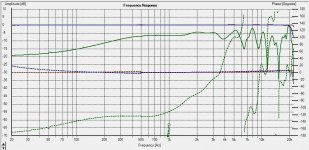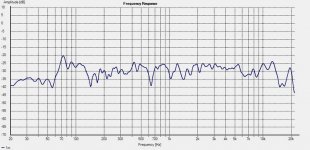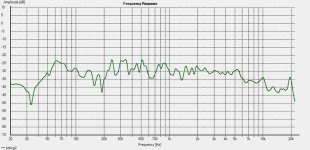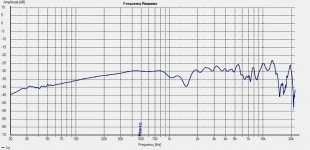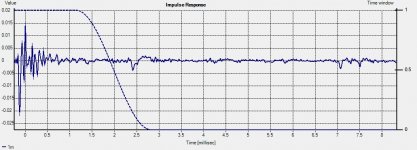Yep, my 4 measure between 85.04 and 85.39 dB 1W @1m
About a 1/3-1/2 dB. Max unit to unit variation (sample size 48) of just over a dB
dave
shot in the dark
For what it's worth, this is the very first measurement I was ale to take of one of my EL70s in nearfield, a week ago. It looks like the gating was set at 1k for this, so under that is irrelevant, right?
At least I got something started. 😛
For what it's worth, this is the very first measurement I was ale to take of one of my EL70s in nearfield, a week ago. It looks like the gating was set at 1k for this, so under that is irrelevant, right?
At least I got something started. 😛
Attachments
By nearfield you mean less than 1cm? If so, change the measurement to raw or 24db/Oct smoothing. Holm automatically sets the gate and it's usually way to high.
For farfield (>10cm) you'll have to set the gate. This takes some learning. I recently helped rpb over on techtalk put together a concise HolmImpulse tutorial. I'm on my phone, but you could try and Google it. He did a bang up job. The PCD stuff was me, he did the rest.
Overall though I can see a hint of similarity. Hard to say yet. And nearfield doesn't properly capture the upper frequencies since they difract off the frame/surround/cab/etc.
Good luck 🙂
For farfield (>10cm) you'll have to set the gate. This takes some learning. I recently helped rpb over on techtalk put together a concise HolmImpulse tutorial. I'm on my phone, but you could try and Google it. He did a bang up job. The PCD stuff was me, he did the rest.
Overall though I can see a hint of similarity. Hard to say yet. And nearfield doesn't properly capture the upper frequencies since they difract off the frame/surround/cab/etc.
Good luck 🙂
Thanks for the tip. I used an older AVS forum thread that google found for me, but I'll look up the PE thread.
Here it is:
A HOLM starter guide - Techtalk Speaker Building, Audio, Video, and Electronics Customer Discussion Forum From Parts-Express.com
Looks great. Cheers.
Here it is:
A HOLM starter guide - Techtalk Speaker Building, Audio, Video, and Electronics Customer Discussion Forum From Parts-Express.com
Looks great. Cheers.
von.ah - That's the one. Should get you going.
wushuliu - No problem. Glad people find it useful. 😉
wushuliu - No problem. Glad people find it useful. 😉
new measurements
Here are a couple updated measurements.
Both are with 1/12 octave smoothing.
Blue is at 1 m on-axis, Green is at the seated position, ~2.5m and ~12 degrees off axis.
Sounds good and looks good! 😀
Fun!
Here are a couple updated measurements.
Both are with 1/12 octave smoothing.
Blue is at 1 m on-axis, Green is at the seated position, ~2.5m and ~12 degrees off axis.
Sounds good and looks good! 😀
Fun!
Attachments
Last edited:
Thanks for adding Von. They look great. I'd suggest gating the impulse response on the 1m measurement. Take a close look at post #5 from that Holm tutorial thread. That'll help take out the reflections from the measurement, but limit the readability to around 300hz and above. Despite this I think I see the same 16khz suck out which is now 4 measurements to confirm it.
The seating position response is really cool to see. You can see how the top firing woofer really fills in the baffle step region. It also shows how the top droops. A very common full ranger "issue". Gives you a great idea of what the power response would look like.
That suck out just below 200hz might be floor bounce. Looks like your room is actually fairly modal free 🙂
The seating position response is really cool to see. You can see how the top firing woofer really fills in the baffle step region. It also shows how the top droops. A very common full ranger "issue". Gives you a great idea of what the power response would look like.
That suck out just below 200hz might be floor bounce. Looks like your room is actually fairly modal free 🙂
Thanks for your reply! The difficulty I had in trying to gate the response was that my impulse results were more ragged than expected.
Here is the attempt at a gated response.
Also as you've noted, there is a definite mode (or two) that I've been aware of when sitting on the couch. If I lean back, there seems to be more mid to upper bass (possibly even too much), but it's considerably lessened when I lean forward. The measurement was more in the forward position because of my hacked together mic boom. 😀
Here is the attempt at a gated response.
Also as you've noted, there is a definite mode (or two) that I've been aware of when sitting on the couch. If I lean back, there seems to be more mid to upper bass (possibly even too much), but it's considerably lessened when I lean forward. The measurement was more in the forward position because of my hacked together mic boom. 😀
Attachments
Last edited:
I see what you mean. You might have needed to turn up the volume. No biggie, the data is useful. The dip at 1500hz is probably still some contamination or reflection, but might be a cancellation from the top woofer. And that gate frequency is pretty high, making it not very useful below about 800hz. It would have helped to raise the speaker up, but that's a pain with a speaker like that.
The treble mountain range has similarities to my data.
It would be interesting if you measured at 10 and 20 degrees above axis to see what happens at 1500hz. If that swings in the vertical axis, then I'd suggest it's the upper woofer.
Thanks again!
The treble mountain range has similarities to my data.
It would be interesting if you measured at 10 and 20 degrees above axis to see what happens at 1500hz. If that swings in the vertical axis, then I'd suggest it's the upper woofer.
Thanks again!
Not loud enough you say... 😀 I actually went as loud as comfortable for the sweep measurements, after setting the gain on the mic preamp to barely not clip with one of my seriously loud finger snaps at ~ 1m (everyone has to have a talent, right? 😀). I freaked out when I tried the pink noise-like signal, however. Ha! That'll get yer heart going. I neglected to peek at the clip indicators during a sweep, though...
I like the idea of taking varied height measurements, but my measurement window has expired and I've put it all away for now.
I like the idea of taking varied height measurements, but my measurement window has expired and I've put it all away for now.
Last edited:
Well, could be that the mic clipped then. Did Holm give you a message saying there was digital clipping?
Finger snap, ha. I probably can't snap as loud as you, but that's what I do as well. Talking into the mic feels stupid. Even when I'm alone. 😀
Finger snap, ha. I probably can't snap as loud as you, but that's what I do as well. Talking into the mic feels stupid. Even when I'm alone. 😀
It also shows how the top droops. A very common full ranger "issue". Gives you a great idea of what the power response would look like.
Not just for FRs. At the listening position in a normal room the curves will show a bit of droop at the highest frequencies.... if it is flat, then the speaker is likely too hot sounding.
To get a better idea of the response at the listener grid, and averaged measurement of each loudspeaker in a rectangular grid centred on the ears is suggested. John Atkinson details the grid he used in one of his posts... i'd suggest this a good standard to follow.
dave
No message of clipping, and the graphs show -30 db signals...Well, could be that the mic clipped then. Did Holm give you a message saying there was digital clipping?
You've bravely pointed out something indicative of the human condition, even in speaker measurements. 😀Talking into the mic feels stupid. Even when I'm alone. 😀
Thanks for the input, Dave. I was thinking the same thing about the HF drop. Cheers.
I'll check out the grid method.

All this putzing around with technical things in which I have very little skill has ultimately led me to just listen for a couple hours at a louder level than I would with a full house. And I'm just enjoying it.

Not just for FRs. At the listening position in a normal room the curves will show a bit of droop at the highest frequencies....
That's true. Rooms absorb those frequencies more easily. You don't feel FR'ers are more prone to it? Von's measurement looks like more of a droop than most room measurements. He was also off axis 12 degrees, so that might be why it looks like more than normal.
Something sweet going on here that is a "plus" for fullrangers, is the lack of a valley/mountain combo from 1000hz to 3000hz that a typical TM would give.
All this putzing around with technical things in which I have very little skill has ultimately led me to just listen for a couple hours at a louder level than I would with a full house. And I'm just enjoying it.
NICE 😀
valley/mountain combo
That's making a wide ranger out of me. If it isn't FR it's phase erasing the depth. Not flat? Wah!
That's making a wide ranger out of me. If it isn't FR it's phase erasing the depth. Not flat? Wah!
sarcasm
Actually none of it. The only new driver I can even remotely consider buying is the EL70 or another MA piece. Currently I'm in love with a 6 1/2 inch Philco branded FR that I think is a Matsushita, 16 ohm in an omni box that I'm guessing was a "surround" add-on once upon a time. No low bass, no very high end, how would I know I'm 66; it never gets it wrong in the middle. The drum kit is always to the rear, the vocal is always in the center, there's just no confusion. All I did was dope the cone and surround as usual and repot so to speak into a surplus box, formerly Teac. This thing kicks ***. Not great; just wonderful. I am not motivated to upgrade it. Of course I have several other systems that I AM motivated to upgrade.
Actually none of it. The only new driver I can even remotely consider buying is the EL70 or another MA piece. Currently I'm in love with a 6 1/2 inch Philco branded FR that I think is a Matsushita, 16 ohm in an omni box that I'm guessing was a "surround" add-on once upon a time. No low bass, no very high end, how would I know I'm 66; it never gets it wrong in the middle. The drum kit is always to the rear, the vocal is always in the center, there's just no confusion. All I did was dope the cone and surround as usual and repot so to speak into a surplus box, formerly Teac. This thing kicks ***. Not great; just wonderful. I am not motivated to upgrade it. Of course I have several other systems that I AM motivated to upgrade.
I brought these home into my livingroom a while ago and I've found the baffle losses noticable enough to prompt me to investigate baffle step compensation. I probably won't use any, but thought I'd share.
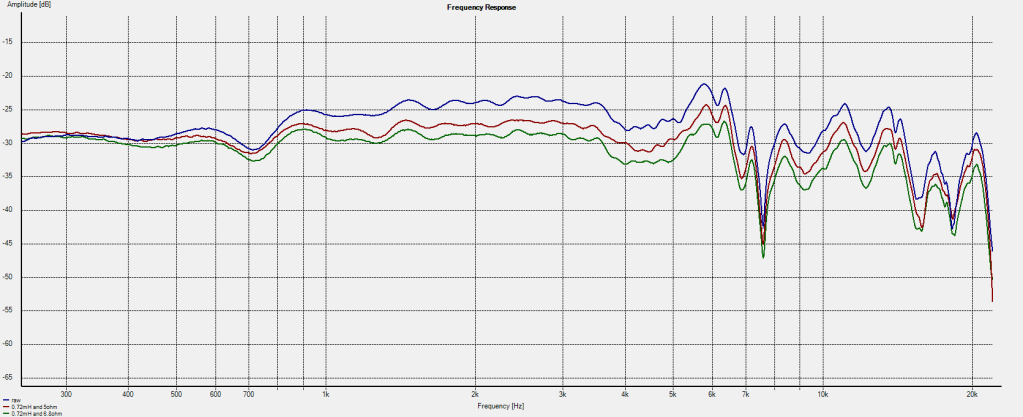
Blue is raw without filter.
Red is 0.72mH and 5ohms.
Green is 0.72mH and 6.8ohms.
The sweeps did sound much more flat. Probably would sound best with the 5ohms. Reminder that this is a 7" wide baffle. A wider baffle would probably want a .9mH or even a 1mH inductor.
If I get around to it, I'll listen to it like this.

Blue is raw without filter.
Red is 0.72mH and 5ohms.
Green is 0.72mH and 6.8ohms.
The sweeps did sound much more flat. Probably would sound best with the 5ohms. Reminder that this is a 7" wide baffle. A wider baffle would probably want a .9mH or even a 1mH inductor.
If I get around to it, I'll listen to it like this.
- Status
- Not open for further replies.
- Home
- Loudspeakers
- Full Range
- EL70 frequency response measurements
